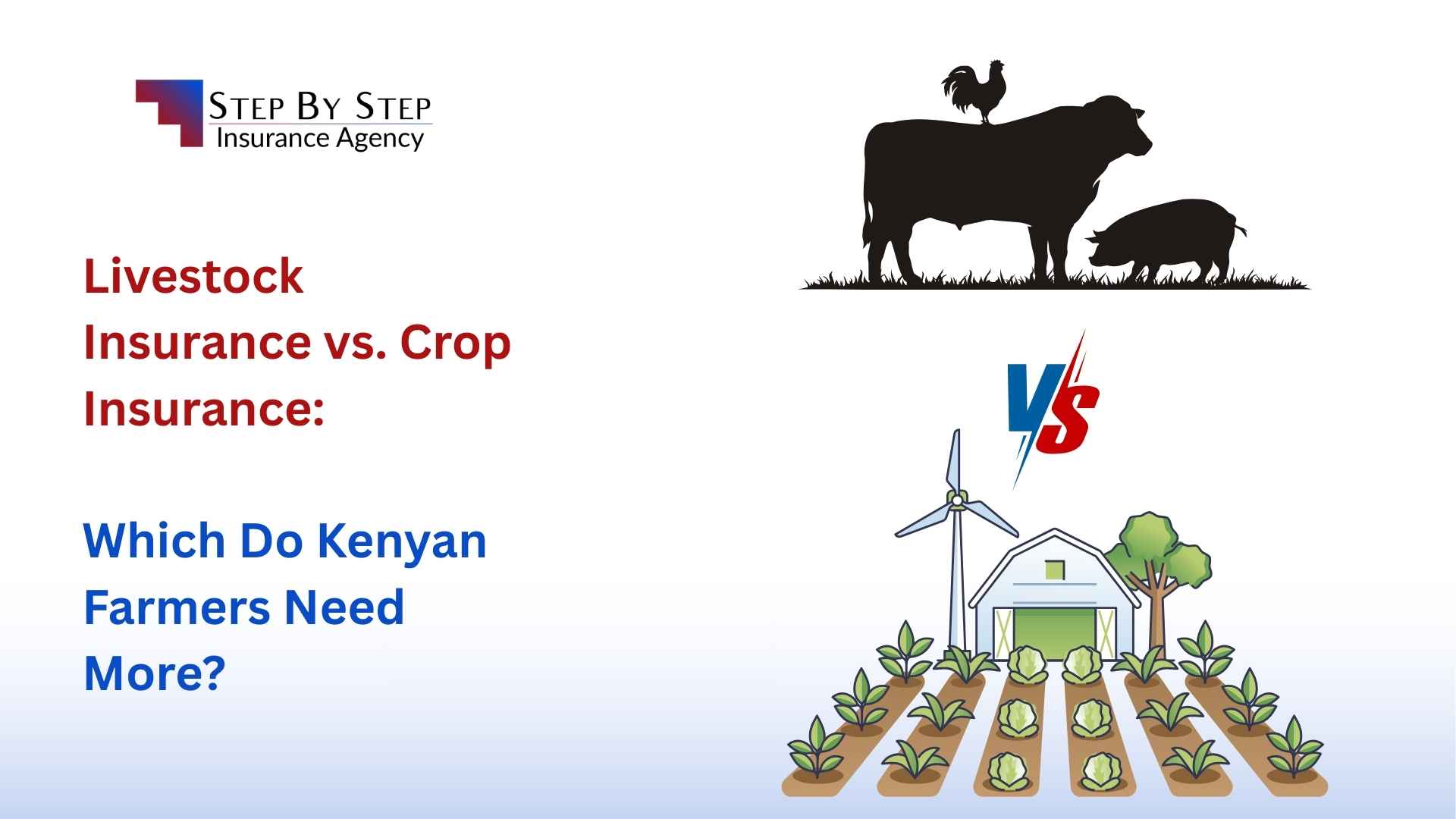Livestock Insurance vs. Crop Insurance: Which Do Kenyan Farmers Need More?
Agriculture is the backbone of Kenya’s economy — employing nearly 70% of rural households. Yet, farming in Kenya is also one of the riskiest livelihoods. From unpredictable weather patterns to disease outbreaks and market volatility, farmers constantly face threats that can wipe out years of hard work in just a few days.
To cushion farmers, agricultural insurance has become one of the most reliable safety nets. The two most common types are:
- Livestock Insurance
- Crop Insurance
But the big question remains: Which one do Kenyan farmers need more? Let’s break it down.
🔑Key Takeaways
- Livestock insurance protects pastoralists and dairy farmers from animal deaths due to drought, disease, and disasters
- Crop insurance covers farmers against weather-related crop failures, pests, and diseases
- ASAL region farmers need livestock insurance more, while high-rainfall area farmers require crop insurance
- Mixed farmers benefit from combining both insurance types for comprehensive protection
- Government programs like KLIP and private insurers offer tailored solutions for different farming needs
📋Table of Contents
💬Join Our Insurance Community
Connect with fellow farmers and stay updated on the latest insurance trends, tips, and news in Kenya’s agricultural sector!
📱Join WhatsApp Group🐄What is Livestock Insurance?
Livestock insurance is designed to protect farmers from the financial losses that occur when animals die due to drought, disease, accidents, predation, or natural disasters.
✅What It Covers:
- Death of cattle, goats, sheep, camels, or poultry
- Losses due to drought, disease outbreaks, and floods
- In some policies, theft and accidents
🐄Who Needs It Most?
- Pastoralists in arid and semi-arid lands (ASALs) such as Turkana, Kajiado, Marsabit, and Garissa
- Smallholder dairy farmers in Central and Rift Valley
- Commercial livestock producers
💡Example: A herder in Turkana who loses half his herd to drought can be compensated under livestock insurance, helping him restock instead of starting from scratch.
For comprehensive livestock protection, consider exploring Madison Livestock Insurance options that specifically cater to protecting valuable animals across different farming operations.
🌾What is Crop Insurance?
Crop insurance provides compensation to farmers when crops fail due to drought, floods, pests, or diseases.
✅What It Covers:
- Weather-related losses (drought, excess rainfall, floods)
- Pests and disease outbreaks
- In some cases, fire damage
🌾Who Needs It Most?
- Maize, wheat, beans, and rice farmers
- Cash crop growers (tea, coffee, sugarcane, cotton)
- Horticultural farmers producing vegetables and fruits
💡Example: A maize farmer in Uasin Gishu who loses their entire harvest due to fall armyworm infestation can recover losses through crop insurance.
Agribusiness owners can benefit from comprehensive coverage through specialized programs like Farm Protector Insurance, which offers tailored protection for diverse agricultural operations.
⚖️Key Differences Between Livestock & Crop Insurance
| Feature | Livestock Insurance 🐄 | Crop Insurance 🌾 |
|---|---|---|
| Main Risk Covered | Animal death (drought, disease, accidents) | Crop failure (drought, floods, pests, disease) |
| Who It Benefits | Pastoralists, dairy farmers, ranchers | Smallholder farmers, cash crop & horticulture producers |
| Payout Trigger | Death or loss of insured livestock | Crop failure based on yield/weather index |
| Seasonality | Year-round (animals are kept year-long) | Seasonal (depends on planting & harvest cycles) |
🔗Related Insurance Resources
| Resource Type | Description | Link |
|---|---|---|
| Livestock Protection | Comprehensive guide to Madison Livestock Insurance | Learn More |
| Success Stories | World Bank livestock insurance disbursements to Kenyan farmers | Read Case Study |
| Agribusiness Coverage | Complete Farm Protector Insurance guide | View Guide |
🎯Which is More Important for Kenyan Farmers?
👉 The answer depends on where you farm and what you depend on for income:
- If you live in ASAL counties, where drought often kills thousands of animals, Livestock Insurance is critical.
- If you are in high rainfall areas and depend on crops for both food and income, then Crop Insurance is a must-have.
- Many mixed farmers (who keep both crops and animals) actually need a combination of both for complete protection.
🏛️Government and Private Sector Support
In Kenya, both government-backed programs and private insurers are working to make agricultural insurance more accessible:
- The Kenya Livestock Insurance Programme (KLIP), supported by the government and donors, targets pastoralists in ASAL counties.
- Insurance companies like APA, Jubilee, and UAP Old Mutual offer both livestock and crop insurance tailored to farmers.
- Some covers are bundled with loans from microfinance institutions, making them affordable to smallholder farmers.
Recent developments show significant progress in agricultural insurance adoption. The World Bank’s Sh1.4 billion disbursement to Kenyan farmers demonstrates the growing impact and reach of livestock insurance programs in protecting rural livelihoods.
🎯Final Word: Which Should You Choose?
If you’re a farmer in Kenya, the type of insurance you need depends on your main source of income:
- 🐄 Livestock farmers → Go for livestock insurance.
- 🌾 Crop farmers → Crop insurance is essential.
- 🐄🌾 Mixed farmers → Consider both to fully safeguard your livelihood.
At Step by Step Insurance, we help farmers find affordable, practical solutions for both crop and livestock risks.
✅Get Protected Today
Ready to secure your farming investment? Our experts are here to help you choose the right insurance coverage.


